Rolls-Royce Heritage Trust
Technical Series Reviews - Page 02
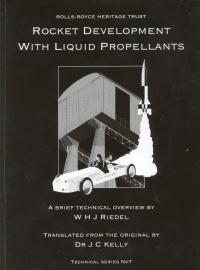 |
Rocket Development with Liquid Propellants
A Brief Technical Overview
by W H J Riedel
Translated from the Original by Dr. JC Kelley
Softbound, 210mm x 297mm x 10mm, 156 pages
ISBN: 1-872922-32-5
Rolls-Royce Heritage Trust
PO Box 31
Derby DE24 8BJ
England
Recommended Retail Price:
Please see Book List/Order Form
84 photographs/diagrams
|
Reviewed by Graham White
Rolls-Royce Heritage Trust Technical Series No. 7
Rocket development has not received anything like the
publicity of, say, piston engines. This book helps fill that void. Based on a
technical paper written by W H J Reidel in 1950 for the British, it offers
excellent insight into German rocket development culminating in the V2. Starting
out with primitive rocket powered cars in the late 1920s, the paper goes through
the evolutionary development steps required for a successful rocket engine.
Critical to the success of a rocket is the guidance system, this pare describes
in fairly good detail the gyroscopes and steering vanes used in the V2.
For the rocket enthusiast I'd say this is a must read book.
Number 7 in the Technical series, it is a larger format than the normal Heritage Trust books being 8-1/4" by
11-5/8" and soft bound. Profusely illustrated with photographs and drawing by
the author, all German captions are translated into English.
As with all Rolls-Royce Heritage Trust books this one
offers unbelievable value for money.
 |
The Allison Engine Catalog
1915-2007
by John M. Leonard
Softbound, 215mm x 280mm x 15mm, 282 pages
ISBN: 978-1-872922-38-6
Rolls-Royce Heritage Trust
P.O. Box 31
Derby DE24 8BJ
England
Recommended Retail Price:
Please see Book List/Order Form
300 b/w photographs/drawings
|
Reviewed by Kimble D. McCutcheon
Rolls-Royce Heritage Trust Technical Series No. 9
This book provides a broad and fascinating survey of
Allison engines and products, covering nearly everything except proprietary
(vehicle transmission and GM diesel engine production) and still-classified
aerospace products. While it does not attempt to address every model where there
were many variants (such as the V-1710), it makes up for the lack of such
minutia by exposing the reader to many new concepts, projects and products.
John Leonard, a third-generation Allison employee and
long-time editor/contributor of the Rolls-Royce Heritage Trust Allison Branch
Newsletter, has combined his vast knowledge of Allison engines with pictures,
drawings and information from the Allison archives to produce this very
enjoyable work.
Chapter 1, Piston Engines, covers Allison's work on
the Liberty engine, its variants and myriad gearbox concepts. In addition to
specifications and historical précis of selected models from the V-1710 series,
V-3420 series, and DV-6840, relatively obscure concepts such as fuel injection,
remote gearboxes (some facilitating multiple engines) and turbocompounding are
presented.
Chapter 2, Turboprop, Turboshaft and Propfan Engines,
includes the T38, T40, T54, T56 (powerplant for the Lockheed Electra and C-130),
and Model 250 (helicopter) series. There is additional discussion of several
afterburning and recuperated models, as well as test rigs, gearboxes and work on
supersonic propellers.
Chapter 3, Turbojet and Turbofan Engines, includes
numerous series, such as the J31, J33, J35, J71, TF41, and AE3007. Also covered
are various lift-fan engines, such as the Model 610 and XJ-99.
Chapter 4, Ramjet and Rocket Engines, features
Allison's experimental work on the PD-37 ramjet and rocket motor cases. While
these activities yielded no production contracts, they did equip the company to
build propellant tanks for the Apollo Command/Service and Lunar Excursion
Modules.
Chapter 5, Automotive and Industrial Engines,
details the gas turbine components and complete engines Allison designed and
built for numerous customers including the General Motors Research Laboratory,
US Army, US Navy, and US Department of Energy. These engines were intended to
power automobiles, armored vehicles, busses, locomotives, boats, generators and
auxiliary power units. Many of these engines were recuperated. Some were aimed
at extremely high fuel economy and low emissions. Several were multi-fueled; a
couple burned coal and one even burned wood!
Chapter 6, Development and Demonstration Engines, is
comprised of advanced-concept demonstrators used to investigate high-Mach
missile propulsion, high turbine inlet temperature, cooled turbine blades,
variable-flow turbines, advanced gas generators, advanced materials and variable
cycles.
Chapter 7, Engine Concepts, looks at paper studies
that apparently never reached the hardware stage. Of note was a two-stroke V-12
reversible diesel for airship power, a 9,000 hp turboprop, a 10,500 hp coupled
turboprop, a two-turbine turbojet with an interburner between the turbine
stages, a few recuperated turboprops, several lift fan engines, and a nuclear
rocket engine that appears to have been intended for atmospheric use.
Chapter 8, Other Products, examines the components
Allison has designed and built over the years. These include parts for WWI
vehicles, marine and aviation propeller reduction gearboxes, steel-backed
bearings, Roots blowers, various clutches, fuel cells, and a compact nuclear
reactor intended to power a portable ammonia generator that would provide fuel
for an army from air and water.
Some Allison Records:
- The V-1710 was the first 1,000 hp piston engine to pass a 150-hr type test
- The J35-A-33 was the first afterburning turbojet to enter production
- Allison was the first company to build 25,000 jet engines
- The Convair XFY-1 "Pogo", powered by an Allison T40-A-14, was the first tail-sitting fighter to take off vertically, fly horizontally, and land vertically
- The T56 is the only turboprop to have been in production for 50 years
- Allison built the only regenerative turbine engine that flew (Model 250-F3)
- Allison was the only company to produce turboprop (AE1107), turboshaft (AE 2100)and turbofan (AE 3007) engines using the same core
- Allison steel-backed bearings were the best available from the late 1920s through mid-1940s
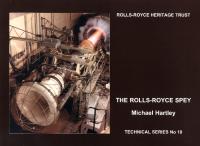 |
The Rolls-Royce Spey
by Michael Hartley
Softbound, 295mm x 210mm x 8mm, 127 pages
ISBN: 978-1-872922-26-3
Rolls-Royce Heritage Trust
P.O. Box 31
Derby DE24 8BJ
England
Recommended Retail Price:
Please see Book List/Order Form
84 photographs/illustrations
|
Reviewed by Kimble D. McCutcheon
Rolls-Royce Heritage Trust Technical Series No. 10
The Rolls-Royce Spey, which entered service in 1964, was
arguably the first turbofan engine designed specifically for commercial use. It
later was also used in military applications as the core engine was modified and
enhanced. The Spey's predecessor (12,000 lbT RB-141) was initially envisaged as
power for the three-engine de Havilland DH121. However, British European Airways
changed the requirement to a smaller airframe, ultimately resulting in the 9,850
lbT RB-163-1, which was later named the Spey. Variants found numerous
applications, including the Trident, BAC 111, Buccaneer, F28, Gulfstream,
Nimrod, Phantom and Corsair. The Spey has been used in marine and industrial
applications and currently holds the world land speed record. More severe noise
rules and requirements for better fuel economy ultimately ended Spey aero engine
production after 5,646 were built. Industrial and marine engines are still being
produced.
Broad application of the Spey involved numerous changes to
the basic design, and this book details the more significant ones. All Speys
were two-shaft engines. Nearly all had 3, 4 or 5-stage low-pressure compressors,
11 or 12-stage high-pressure compressors, 2-stage high-pressure turbines and
2-stage low-pressure turbines. The TF41 had a 3-stage low-pressure, 2-stage
intermediate-pressure and 11-stage high-pressure compressor. Industrial and
marine variants have an additional 2-stage power turbine.
The book is full of development and technical detail, with
at least one high-quality illustration or photograph on nearly every spread;
most are in color. Another attractive feature of the book is its landscape
format, which lends itself to the presentation of gas turbine images. This is
the second such book produced by the Rolls-Royce Heritage Trust, the first being
Fast Jets, which tells the story of reheat.
Among the intriguing details is a long description of the
fuel control system, which broke new ground in terms of reliability,
acceleration control, surge margins over a wide range of flight conditions, and
accuracy. Lucas designed, developed and funded the fuel control system using
control laws and parameters that were very different from previous engines. The
design employed full-flow metering and spinning valves to alleviate problems
with hysteresis and friction that had arisen in previous systems as a result of
fuel contamination and specific gravity variations.
Similar rich detail accompanies the discussions of
compressor, burner and turbine development, as well as the many modifications
that were made during its service life.
Like other Rolls-Royce Heritage Trust books, this one meets
high standards for its writing, editing, illustration and production. It would
be a bargain at twice the price.
 |
Jim Allison’s Machine Shop: The First 30 Years
by John M. Leonard
Hardbound , 11.2" x 8.6" x 0.7", 260 pages
ISBN-13: 978-1-872922-492
Rolls-Royce Heritage Trust (2016)
Available through Amazon.com
Recommended Retail Price: US $40.00
235 pictures/diagrams, black and white |
Reviewed by Kimble D. McCutcheon - 8 December 2016
Rolls-Royce Heritage Trust Technical Series No. 12
John Leonard's exploration of the Rolls-Royce Heritage Trust, Allison Branch archives has led to another intriguing look into Allison history. While his last book, The Allison Engine Catalog, presented brief descriptions of Allison engines and products, and covered the period of 1915 - 2007, this one provides a substantially deeper treatment of the early years, 1915 - 1945.
Leonard begins with coverage of Jim Allison's personal life, interests and business ventures. He continues with biographical sketches of Jim's friends, business partners and key employees.
Next, Leonard devotes 39 pages to the history and evolution of the many Allison buildings built mostly in and around the town of Speedway, Indiana. Speedway was the brainchild of Carl Fisher, who, along with Jim Allison and others, had founded the Indianapolis Motor Speedway in 1906. Allison was also an investor in the town of Speedway, which provided housing for his employees. Leonard's coverage of the Allison Plants includes numerous maps and photographs.
Several key Allison development projects and products are covered in depth. These include Allison steel-backed bearings, Liberty engines and modifications, marine engines, the X-4520 (an air-cooled X-24 developed in conjunction with the U.S. Army Air Service Engineering Division), and an airship diesel.
Leonard devotes 24 pages to new Allison V-1710 material that has come to light since the publication of Dan Whitney's Vee's for Victory! This includes drawings, photographs, supercharger development concepts and performance charts. Similarly, new material is presented on the Allison V-3420. Leonard also covers Allison gearboxes, gearbox concepts, and many engine concepts that never entered production. Finally early Allison-built turbojets and turboprops are summarized.
This is not only an easy-to-read technical history, but also is a useful reference. I heartily recommend it to anyone interested in Allison history or the development of engines.
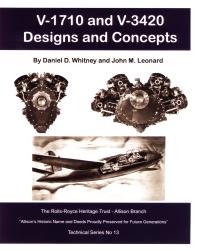 |
V-1710 and V-3420 Designs and Concepts
by Daniel D. Whitney and John M. Leonard
Softbound, 8.0" x 10.0" x 0.87", 369 pages
ISBN-13 978-1-703-33463-0
Rolls-Royce Heritage Trust - Allison Branch
Technical Series No. 13
PO Box 420
Indianapolis, Indiana 46206-0420
(2020)
Recommended Retail Price: $44.99
Lavishly illustrated in color, black and white
|
Reviewed by Kimble D. McCutcheon - 19 Nov 2020
Rolls-Royce Heritage Trust Technical Series No. 13
If ever there was a volume that contains the breadth of Allison's design imagination, this is the one. This extraordinary volume gives an unprecedented look at what goes on behind the scenes as an engine manufacturer develops and refines designs to address new requirements and installations.
This is the work of two authors, neither of whom is a stranger to the aircraft engine history field. Dan Whitney, who wrote Vee's for Victory: The Story of the Allison V-1710, is a retired mechanical and nuclear engineer. John Leonard, who wrote Jim Allison's Machine Shop‑ the First Thirty Years and The Allison Engine Catalog, is a third-generation Allison engineer who is also the Rolls-Royce Heritage Trust ‑ Allison Branch archivist and newsletter editor.
While processing the Allison Branch archival collection, John discovered a number of old microfilm rolls containing heretofore unpublished drawings of proposals, concepts and developments of V-1710, V-3420 and V-6840 engines and installations. John spent countless hours making these drawings suitable for publication, and they form the heart of Allison V-1710 and V-3420 Designs and Concepts. Dan provides background, historical context, commentary and engineering details. Together, Dan and John have produced a fantastic Allison historical reference, as well as an unparalleled exposure of the engine design process.
Topics include Early V-1710 Concepts, Airships and the V-1710-B, Gears and Shafts, Douglas DC-8 (before the jet!), V-1710 Installations, Auxiliary-Stage Superchargers, Turbo-Compound Engines, New (non-V-1710-based) Engines, V-1710 Improvements, Early V-3420 Developments, V-3420 Marine Engines, V-3420 Bevel Gears and Applications, and DV-6840 Engines.
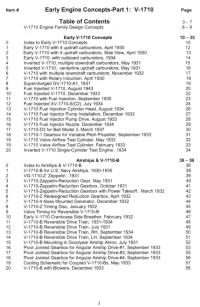 |
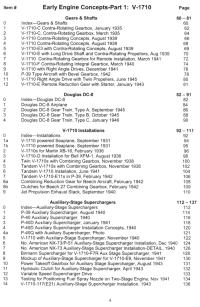 |
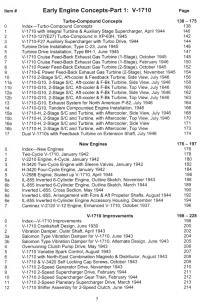 |
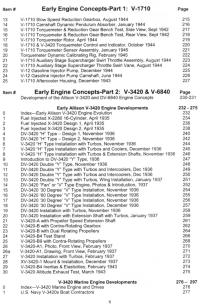 |
 |
| V-1710 and V-3420 Designs and Concepts Table of Contents |
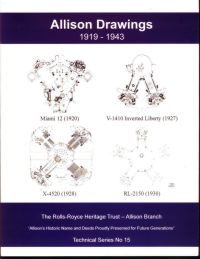 |
Allison Drawings: 1919 – 1943
by John M. Leonard
Softbound, 8.5" x 11.0" x 0.75", 370 pages
ISBN-13 978-8-218-02875-6
Rolls-Royce Heritage Trust - Allison Branch
PO Box 420
Indianapolis, Indiana 46206-0420
(2022)
Recommended Retail Price: US $40.00
Lavish black and white illustrations
|
Reviewed by Kimble D. McCutcheon - 20 Nov 2022
Rolls-Royce Heritage Trust Technical Series No. 15
John Leonard is a third-generation Allison engineer who is also the Rolls-Royce Heritage Trust – Allison Branch archivist and newsletter editor. His previous publications include The Allison Engine Catalog and Jim Allison's Machine Shop – the First Thirty Years.
While processing the Allison Branch archival collection, John discovered a number of old microfilm rolls containing heretofore unpublished proposal concept drawings, including V-1710, V-3420 and V-6840 engines and installations. John spent countless hours making these drawings suitable for publication. Together with Daniel D. Whitney, Leonard co-wrote Allison V-1710 and V-3420 Designs and Concepts, which concentrates on the Allison V-1710 and its developments. Leonard's latest book, Allison Drawings: 1919 – 1943, presents a huge drawing archive that is not part of the V-1710 family.
Allison began as a general purpose machine shop that soon garnered a reputation for innovation and quality. These included gearboxes and shafting for airships, propeller reduction gearing, and numerous engine concepts. Allison Drawings uses a landscape layout throughout, which makes the best use of its large 8.5" x 11.0" pages. For someone interested in mechanisms in general and in Allison history specifically, this book is a real treasure.
Allison Drawings: 1919 – 1943 Contents
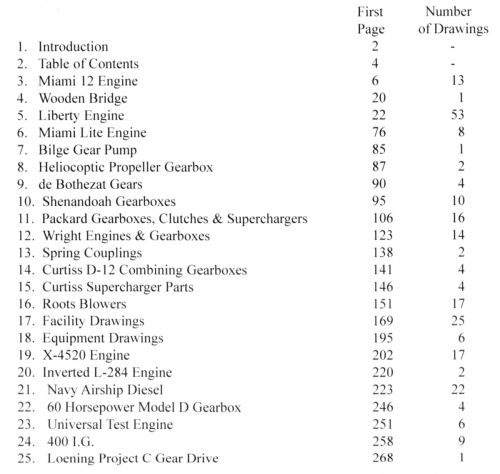 |
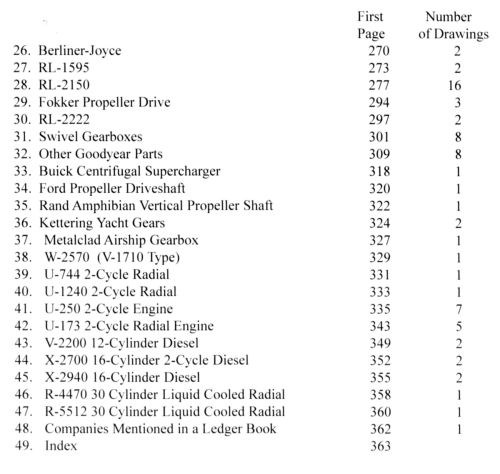 |












